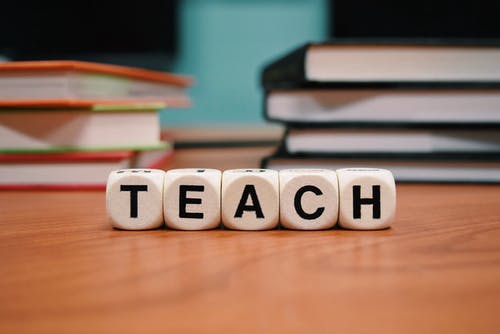Benefits of the Forest Hills Foundation grant find a diverse range of students and teachers

More stories from Natalie Mix

Four teachers receive grants to spice up their classrooms and enhance learning
Principal Steve Passinault has been known to joke about whether biology teacher Kristy Butler or woodshop teacher Robert Miedema has applied for more grants through the Forest Hills Foundation. Butler claims its Miedema. Miedema has not made any comment.
But it’s not really a competition as much as it is two teachers taking advantage of a program that benefits both them and their students in a variety of unique ways. It’s a reflection on the passion these teachers have for their students and the drive they pursue that passion with.
Butler and Miedema have been fortunate enough to receive a significant portion of the grants they have applied for. This year simply adds to the list; they are two of a few teachers who have received grants intended to enhance the quality of learning in their classrooms.
“It’s always great to receive a grant from the foundation,” Butler said. “They have been so supportive over what we need to do. In science, materials are expensive; we definitely go through our budget just to maintain the labs that we [already] do. So when we need other equipment or we need something new, this gives us the opportunity to do [that] for the students.”
Butler and her fellow biology teachers found themselves lacking in particularly engaging materials when they experimented with a new activity this year. The activity—labeled Odd One Out—is a compare and contrast between the characteristics and adaptations of a variety of organisms.
The project encourages students to engage in teamwork and educated discussion about common knowledge through the observation of a group of organisms. They are expected to determine which of the organisms don’t quite fit in with the rest of the group based on a variety of factors and traits.
Unfortunately, this year’s students were unable to experience this activity to its fullest potential. Limited resources left them working with pictures of organisms rather than real-life samples. The grant enables future students to work with a wider variety of organisms in an overall more hands-on experience.
“I think it’s going to benefit [next year’s students to] actually be able to see these organisms preserved,” Butler said. “There’ll be some jarred organisms, and there’ll be some preserved plants [and some] different seeds. So, they’ll actually be able to pick up these things and see some of these things that they might not see anywhere else. It gets their curiosity going.”
The activity is not only a salient component to the unit focused on characteristics and adaptations of organisms, but it’s a step early on in the process of training students to apply key scientific concepts that they will be working with all year.
“It’s really just [about] getting the students to start to do observations, start to collect data, have conversations around something that they all have some common knowledge about,” Butler said.
Later on in the unit, the students take a trip to the zoo to observe creatures in their habitats. They are then expected to redesign a potentially more beneficial habitat for the animal. This “Odd One Out” activity is an important precursor that allows students to practice recording quality observations.
Biology teacher Patricia Richardson believes that the new variety of organisms will create an activity just as important as the zoo project. Combined, the activities complement and build on each other, while each contributing unique components.
“[The “Odd One Out” activity] gives [the students] a chance to see some animals that they wouldn’t see [otherwise],” Richardson said. “We do take all of our kids to the zoo, but this happens before that. And so these are animals that aren’t even at the zoo, like some marine animals.”
Richardson and Butler, as well as the other biology teachers, have collaborated to determine the best way to go about obtaining and putting the grant to use. They are all learning together as they work out the problems they may encounter. The Foundation has been supportive of the endeavor, and as Butler puts it, it’s doing “a great job of making it not too cumbersome for teachers.”
“It’s always nice when we have support for the materials that we need and can give kids the experiences that we think are good for them,” Richardson said. “It’s nice to have that community support from the Foundation.”
Miedema shares her sentiments. He received a grant to purchase a new Festool track saw, a worthy addition to his repertoire of—as Butler put it—”cool stuff that he has down in his room.” It’s not the first time he has received support from the Foundation for new projects in his classroom.
“I get excited about new tools in the shop,” Miedema said, “and I love that the students will be able to have a safer and more efficient experience. I also feel very thankful for the support of the Foundation as they have contributed generously to the Industrial Technology program at Central High.”
The saw will inspire a new level of efficiency and problem-solving in Miedema’s classroom. It’s far more portable than other saws Miedema has worked with and consequently allows his students to cut longer pieces of wood more remotely.
With one more resource at their fingertips, his students can cut down on wasted class time and turn in projects of a higher overall quality. Miedema expects his students to appreciate the new efficiency brought to them by the grant.
“Initially, my advanced students will be able to use this saw almost immediately,” Miedema said. “They will see the benefits of the new saw regularly as their projects are much more diverse and wide-ranging. Within time, all the students that use this will find it a marked improvement.”
As Miedema’s students begin to welcome the idea of classroom improvements, another class in the school is eagerly anticipating the changes they will be undergoing due to the grant.
Biology and forensics teacher Joslyn Burnaby has recently received a grant to purchase a new moveable mannequin that will be put to use during her forensics classes’ four crime scene analyses over the course of the year. Those of her students that are aware of the upcoming changes have big plans for the mannequin.
“They want to name it,” Burnaby said, “and they’re all excited to name it right away. I said we need to wait and see; it might have a certain look [so you want to give it] a certain name.”
The forensics students previously had been working with newspaper-stuffed clothing, a far cry from the realities of crime scene investigation. Burnaby knew that, unfortunately, the science budget wouldn’t accommodate such an expensive purchase; the Foundation grant was her only chance.
As excited and grateful as she is now, Burnaby recalls being worried that she wouldn’t receive the grant. She knew the positive effects that it would have on her students, but it was hard to tell if it would qualify her for the grant.
“I was excited [about the grant],” Burnaby said. “I heard some of them were denied certain grants. So then I’m like, ‘oh no, I might not get this.’ But when they walked in, it was really exciting that I was able to increase our lab supplies as well as get that large purchase mannequin.”
And Burnaby hasn’t lost a bit of that excitement.
The recipients of the grant represent a wide variety of teachers and students, but they all hold one thing in common: the excitement and gratitude of being fortunate enough to receive such a blessing.
So, it doesn’t really matter which teacher has applied for or received more grants. What really matters is the students who are being affected—the students who reap the benefits of teachers who recognize a need and reach out to meet it.
“It definitely directly benefits students because without the grant, then we would have still been very limited on the kind of materials that kids would be able to be using and engaging with,” Butler said. “And it’s a benefit to the teachers because then we can give more to the kids, have deeper conversations, and get started with their thinking.”

Natalie Mix is a senior taking on her fourth and final year as a member of The Central Trend. Room 139/140 and the staff of The Central Trend have been...
























































































